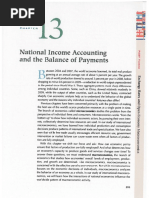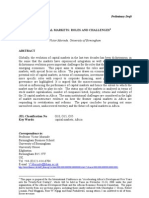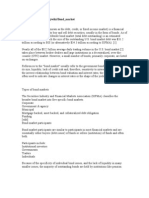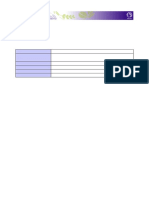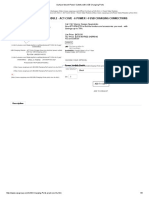Lecture Notes 3
Lecture Notes 3
Uploaded by
windows3123Copyright:
Available Formats
Lecture Notes 3
Lecture Notes 3
Uploaded by
windows3123Original Description:
Copyright
Available Formats
Share this document
Did you find this document useful?
Is this content inappropriate?
Copyright:
Available Formats
Lecture Notes 3
Lecture Notes 3
Uploaded by
windows3123Copyright:
Available Formats
A MACROECONOMIC
19 THEORY OF THE OPEN
ECONOMY
LEARNING OBJECTIVES:
By the end of this chapter, students should understand:
¾ how to build a model to explain an open economy’s trade balance and exchange rate.
¾ how to use the model to analyze the effects of government budget deficits.
¾ how to use the model to analyze the macroeconomic effects of trade policies.
¾ how to use the model to analyze political instability and capital flight.
CONTEXT AND PURPOSE:
Chapter 19 is the second chapter in a two-chapter sequence on open-economy macroeconomics.
Chapter 18 explained the basic concepts and vocabulary associated with an open economy.
Chapter 19 ties these concepts together into a theory of the open economy.
The purpose of Chapter 19 is to establish the interdependence of a number of economic
variables in an open economy. In particular, Chapter 19 demonstrates the relationships between
the prices and quantities in the market for loanable funds and the prices and quantities in the
market for foreign-currency exchange. Using these markets, we can analyze the impact of a
variety of government policies on an economy’s exchange rate and trade balance.
KEY POINTS:
1. To analyze the macroeconomics of open economies, two markets are central—the market for
loanable funds and the market for foreign-currency exchange. In the market for loanable
funds, the interest rate adjusts to balance the supply of loanable funds (from national saving)
and the demand for loanable funds (from domestic investment and net capital outflow). In
the market for foreign-currency exchange, the real exchange rate adjusts to balance the
supply of dollars (for net capital outflow) and the demand for dollars (for net exports).
Because net capital outflow is part of the demand for loanable funds and provides the supply
of dollars for foreign-currency exchange, it is the variable that connects these two markets.
2. A policy that reduces national saving, such as a government budget deficit, reduces the
supply of loanable funds and drives up the interest rate. The higher interest rate reduces net
You might also like
- Get eTextbook 978-0078021770 International Economics (Mcgraw-Hill Series in Economics) 16th Edition free all chapters100% (3)Get eTextbook 978-0078021770 International Economics (Mcgraw-Hill Series in Economics) 16th Edition free all chapters55 pages
- Explain THE SHORT RUN in respect of Macroeconomics aNo ratings yetExplain THE SHORT RUN in respect of Macroeconomics a4 pages
- 12 Allami, Bortz and Cibils From Levy-Orlik Proof 1No ratings yet12 Allami, Bortz and Cibils From Levy-Orlik Proof 111 pages
- Monetary Policy in A Small Open Economy. The Case of Paraguay - BCP - Portal GuaraniNo ratings yetMonetary Policy in A Small Open Economy. The Case of Paraguay - BCP - Portal Guarani22 pages
- Financial Integration, Economic Instability and Trade Structure in Emerging MarketsNo ratings yetFinancial Integration, Economic Instability and Trade Structure in Emerging Markets46 pages
- CH 18 - Policy Under Fixed Exchange Rates PDFNo ratings yetCH 18 - Policy Under Fixed Exchange Rates PDF40 pages
- Course Content International Trade and International Finance Wits 2020No ratings yetCourse Content International Trade and International Finance Wits 20206 pages
- International Economics I For Tutorial DB-1No ratings yetInternational Economics I For Tutorial DB-180 pages
- Capital Markets Roles Challenges Draft1No ratings yetCapital Markets Roles Challenges Draft133 pages
- Meza, Urrutia - 2011 - Financial Liberalization, Structural Change, and Real Exchange Rate AppreciationsNo ratings yetMeza, Urrutia - 2011 - Financial Liberalization, Structural Change, and Real Exchange Rate Appreciations12 pages
- Country Risk and The Mundell Fleming Model Applied R Mundell and M Fleming 1No ratings yetCountry Risk and The Mundell Fleming Model Applied R Mundell and M Fleming 122 pages
- Public Debt Sustainability. Notes On Debt Sustainability, Development of A Domestic Governmet Securities Market and Financial RisksNo ratings yetPublic Debt Sustainability. Notes On Debt Sustainability, Development of A Domestic Governmet Securities Market and Financial Risks24 pages
- Macroeconomics Assignment #1: Name EnrollmentNo ratings yetMacroeconomics Assignment #1: Name Enrollment5 pages
- FRICTIONAL UNEMPLOYMENT Arises Because of TheNo ratings yetFRICTIONAL UNEMPLOYMENT Arises Because of The16 pages
- it's never different_fiscal policy shocks and inflationNo ratings yetit's never different_fiscal policy shocks and inflation37 pages
- Macroeconomics For Developing Countries by Raghbendra Jha (Z-Lib - Org) - 208-224No ratings yetMacroeconomics For Developing Countries by Raghbendra Jha (Z-Lib - Org) - 208-22417 pages
- Module 1 Module in International EconomicsNo ratings yetModule 1 Module in International Economics18 pages
- The Macroeconomics of Open Economies Group 11No ratings yetThe Macroeconomics of Open Economies Group 1122 pages
- Modern Money Theory: A Criticism From The Periphery Rodrigo Vergnhanini Bruno de ContiNo ratings yetModern Money Theory: A Criticism From The Periphery Rodrigo Vergnhanini Bruno de Conti16 pages
- The Mundell-Fleming Economic Model: A crucial model for understanding international economicsFrom EverandThe Mundell-Fleming Economic Model: A crucial model for understanding international economicsNo ratings yet
- Liquidity Traps - How To Avoid Them and How To Escape Them - Buiter - PanigirtzoglouNo ratings yetLiquidity Traps - How To Avoid Them and How To Escape Them - Buiter - Panigirtzoglou71 pages
- Documentos de Política Económica: Banco Central de ChileNo ratings yetDocumentos de Política Económica: Banco Central de Chile29 pages
- Evolution or Revolution?: Rethinking Macroeconomic Policy after the Great RecessionFrom EverandEvolution or Revolution?: Rethinking Macroeconomic Policy after the Great Recession5/5 (1)
- Management: Theory and Practice, and Cases: Richard L. NolanNo ratings yetManagement: Theory and Practice, and Cases: Richard L. Nolan21 pages
- Managing Exploration Processes For New Business - The Successes and Failures of Fujifilm and KodakNo ratings yetManaging Exploration Processes For New Business - The Successes and Failures of Fujifilm and Kodak40 pages
- Problem Set 1 - Some Answers SE312 Spring 2018 Rahman: Page 1 of 5No ratings yetProblem Set 1 - Some Answers SE312 Spring 2018 Rahman: Page 1 of 55 pages
- Open-Economy Macroeconomics: Basic Concepts: Learning ObjectivesNo ratings yetOpen-Economy Macroeconomics: Basic Concepts: Learning Objectives1 page
- Problem Set 1 - Some Answers SE312 Spring 2018 Rahman: Page 1 of 5No ratings yetProblem Set 1 - Some Answers SE312 Spring 2018 Rahman: Page 1 of 55 pages
- Surface Mount Power Outlets With USB Charging PortsNo ratings yetSurface Mount Power Outlets With USB Charging Ports6 pages

